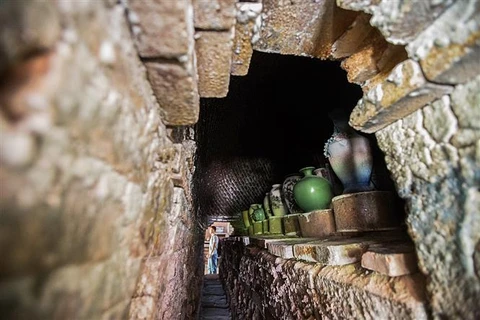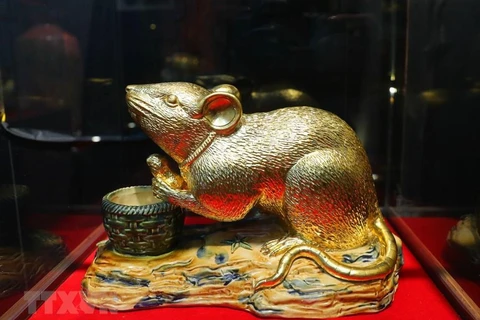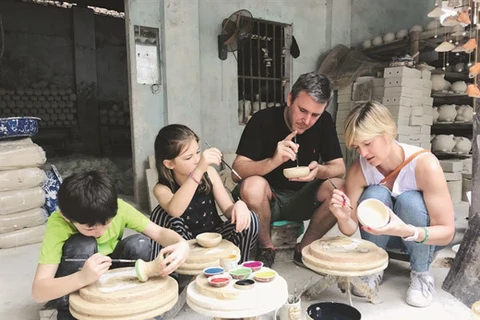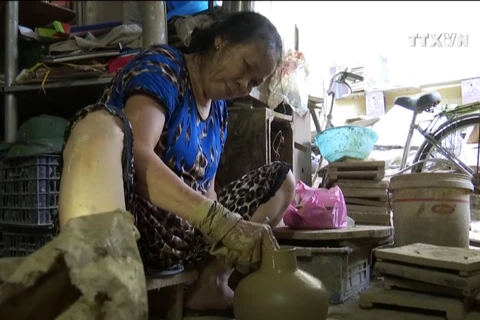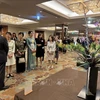Hanoi (VNS/VNA) - Dare to think different and take a risk – that’s the path young artisan Vu Nhu Quynh has taken to succeed.
She has heightened the value and aesthetic of traditional ceramic products in her hometown – Bat Trang village in Gia Lam district on the outskirts of Hanoi – by thinking outside the box: applying delicate gold-inlaid embossed designs onto her products.
Handmade, Quynh’s ceramic products are harmonious combinations of both modern and traditional elements, and have been highly praised for their sophistication.
According to the 33-year-old artisan, the craft of making ceramic products have been pursued by three generations of her family, so she has been used to the scent of the clay since she was a little girl.
But Quynh did not realise her passion for ceramics in those early days. After graduating from high school, instead of following her family’s craft, she chose to study fashion design at the University of Industrial Fine Arts.
“I was enthusiastic about fashion design at that time. I ran a big clothing store in my hometown after graduating from university. But it seems I chose the wrong profession at that time. I studied designing dresses and suits but few villagers wore them back then,” she recalled.
Unsuccessful with her start-up business, Quynh decided to put away her tailor’s scissors and chalk to take up her family’s craft.
“The artistic knowledge about shapes, colours and designs that I gained during my studies at university could be creatively applied on ceramic products,” she said.
Her family used to focus on producing household items like bowls and dishes to sell to the domestic market. However, she realised these products were already being mass produced by other workshops. On the other hand, ceramic products used for worshipping were mainly exported and those available at home were few and far between.
She then started to think about finding outlets for her family’s products – creating ceramic objects for spiritual uses with high aestheticism.
“The idea of creating ceramic items with embossed designs was predestined for me. I had been impressed by beautiful wooden pictures with raised designs and that inspired me to use the same idea on ceramics.
“I started with my first sketch, but as a pioneer of embossing designs on ceramics in Bat Trang Village, I encountered many difficulties,” she recalled.
Quynh embarked on her mission by restoring and renewing ancient designs which she could apply on contemporary ceramics. This way, her products not only preserve the imprints of Vietnamese culture but also manifest modern elements to give them a contemporary edge.
For example, ancient ceramic items used to be painted with simple designs of peaches or peony flowers that symbolise prosperity and power. The young artisan therefore innovated these simple designs by applying them in 3D on traditional ceramics.
The first ceramic product with 3D designs took Quynh up to one year to finish with countless experiments and failures. She says the most difficult part is preserving the embossed designs after heating the object at a high temperature.
Moreover, the colours needed to be harmonious and diverse instead of monochromatic like those on other ceramic objects. The young artisan therefore thought of painting different shades of dark and light onto the designs to create impressive 3D effects.
After each failure, Quynh drew her own experience of heating, colouring and preparing the material.
“First, the object is shaped with a mould or by hand. After that, I draw the sketches for the 3D designs which are then applied to the surface of the product. That step demands skill and patience from the artisan,” Quynh said.
“After the object has been heated at 900 degrees Celsius, it is painted and enamelled and then fired again at 1,200Celsius. After the second firing, we have a finished product. Each step is equally important as they all contribute to the perfection of the final product.
“In the first three years of experimenting, I broke so many items they could have been used to pave a floor of up to a hundred square metres!”
Quynh’s patience and determination finally paid off when her ceramic products with embossed designs were perfected and accepted by customers. The embossed designs were even inlaid with 18-carat gold.
Having mastered the technique, Quynh started to make more products and diversify her designs.
According to her, each product takes a different amount of time to finish depending on its sophistication and size.
For example, a big vase might take half a year but in exchange, the value of the product increases as well. While a big vase might cost up to 1 billion VND (43,000 USD), a smaller one can be sold for several hundred thousand đồng.
The most sophisticated product that Quynh and the other artisans at her company have created is a pair of ornamental jars that are 1.8m high and 1.1m in diameter. The jars took them a year to complete.
Presently, her company employs 200 artisans and workers, focusing on ceramic worshipping and feng-shui objects with over 25 agencies nationwide.
“My products are mainly purchased by domestic customers. In the future, I will improve shipping services to serve foreign customers as well,” Quynh said.
She also reveals that she is planning to diversify her ceramic products by producing more practical items like gifts, vases and tableware featuring imprints of Vietnamese culture to introduce to more international friends./.
She has heightened the value and aesthetic of traditional ceramic products in her hometown – Bat Trang village in Gia Lam district on the outskirts of Hanoi – by thinking outside the box: applying delicate gold-inlaid embossed designs onto her products.
Handmade, Quynh’s ceramic products are harmonious combinations of both modern and traditional elements, and have been highly praised for their sophistication.
According to the 33-year-old artisan, the craft of making ceramic products have been pursued by three generations of her family, so she has been used to the scent of the clay since she was a little girl.
But Quynh did not realise her passion for ceramics in those early days. After graduating from high school, instead of following her family’s craft, she chose to study fashion design at the University of Industrial Fine Arts.
“I was enthusiastic about fashion design at that time. I ran a big clothing store in my hometown after graduating from university. But it seems I chose the wrong profession at that time. I studied designing dresses and suits but few villagers wore them back then,” she recalled.
Unsuccessful with her start-up business, Quynh decided to put away her tailor’s scissors and chalk to take up her family’s craft.
“The artistic knowledge about shapes, colours and designs that I gained during my studies at university could be creatively applied on ceramic products,” she said.
Her family used to focus on producing household items like bowls and dishes to sell to the domestic market. However, she realised these products were already being mass produced by other workshops. On the other hand, ceramic products used for worshipping were mainly exported and those available at home were few and far between.
She then started to think about finding outlets for her family’s products – creating ceramic objects for spiritual uses with high aestheticism.
“The idea of creating ceramic items with embossed designs was predestined for me. I had been impressed by beautiful wooden pictures with raised designs and that inspired me to use the same idea on ceramics.
“I started with my first sketch, but as a pioneer of embossing designs on ceramics in Bat Trang Village, I encountered many difficulties,” she recalled.
Quynh embarked on her mission by restoring and renewing ancient designs which she could apply on contemporary ceramics. This way, her products not only preserve the imprints of Vietnamese culture but also manifest modern elements to give them a contemporary edge.
For example, ancient ceramic items used to be painted with simple designs of peaches or peony flowers that symbolise prosperity and power. The young artisan therefore innovated these simple designs by applying them in 3D on traditional ceramics.
The first ceramic product with 3D designs took Quynh up to one year to finish with countless experiments and failures. She says the most difficult part is preserving the embossed designs after heating the object at a high temperature.
Moreover, the colours needed to be harmonious and diverse instead of monochromatic like those on other ceramic objects. The young artisan therefore thought of painting different shades of dark and light onto the designs to create impressive 3D effects.
After each failure, Quynh drew her own experience of heating, colouring and preparing the material.
“First, the object is shaped with a mould or by hand. After that, I draw the sketches for the 3D designs which are then applied to the surface of the product. That step demands skill and patience from the artisan,” Quynh said.
“After the object has been heated at 900 degrees Celsius, it is painted and enamelled and then fired again at 1,200Celsius. After the second firing, we have a finished product. Each step is equally important as they all contribute to the perfection of the final product.
“In the first three years of experimenting, I broke so many items they could have been used to pave a floor of up to a hundred square metres!”
Quynh’s patience and determination finally paid off when her ceramic products with embossed designs were perfected and accepted by customers. The embossed designs were even inlaid with 18-carat gold.
Having mastered the technique, Quynh started to make more products and diversify her designs.
According to her, each product takes a different amount of time to finish depending on its sophistication and size.
For example, a big vase might take half a year but in exchange, the value of the product increases as well. While a big vase might cost up to 1 billion VND (43,000 USD), a smaller one can be sold for several hundred thousand đồng.
The most sophisticated product that Quynh and the other artisans at her company have created is a pair of ornamental jars that are 1.8m high and 1.1m in diameter. The jars took them a year to complete.
Presently, her company employs 200 artisans and workers, focusing on ceramic worshipping and feng-shui objects with over 25 agencies nationwide.
“My products are mainly purchased by domestic customers. In the future, I will improve shipping services to serve foreign customers as well,” Quynh said.
She also reveals that she is planning to diversify her ceramic products by producing more practical items like gifts, vases and tableware featuring imprints of Vietnamese culture to introduce to more international friends./.
VNA

